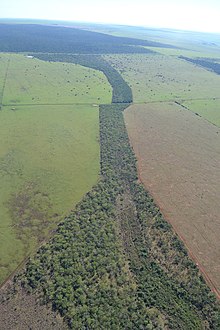User:AMileAMinute/Wildlife corridor

First Section I Am Working On - AMileAMinute
[edit]A wildlife corridor, also known as a habitat corridor, or green corridor, is an designated area that connects wildlife populations that have been separated by human activities or structures, such as development, roads, or land clearings. These corridors enable movement of individuals between populations, which helps prevent negative effects of inbreeding and reduced genetic diversity, often caused by genetic drift, that can occur in isolated populations. Additionally, corridors support the re-establishment of populations that may have been reduced or wiped out due to random events like fires or disease. They can also mitigate some of the severe impacts of habitat fragmentation, a result of urbanization that divides habitat areas and restricts animal movement. Habitat fragmentation from human development poses an increasing threat to biodiversity, and habitat corridors help to reduce its harmful effects. Corridors aside from their benefit to vulnerable wildlife populations can conflict with communities surrounding them when human-wildlife conflicts are involved.[1] In other communities the benefits of wildlife corridors to wildlife conservation are used and managed by indigenous communities.[2]
Second Section I Am Working On
[edit]Purpose
[edit]Habitat corridors can be considered a management tool in areas where the destruction of a natural habitats has severely impacted native species, whether due to human development or natural disasters. When land is fragmented, wildlife populations may become unstable or isolated from larger populations.[3] These management tools are used by ecologists, biologists, indigenous tribes, and other concerned parties that oversee wildlife populations. Corridors help reconnect these fragmented populations and reduce negative population fluctuations by supporting these key aspects that stabilize populations[4]:
- Colonization: Animals can move and occupy new areas when food sources or other natural resources are scarce in their primary habitat.
- Migration: Species that relocate seasonally can do so more safely and effectively without interference from human development barriers.
- Interbreeding: Animals can find new mates in neighboring regions, increasing genetic diversity.
- Tribes: Indigenous groups use wildlife corridors as an effective management strategy to sustain their physical and spiritual needs.[2]
Third Section I am Working On
[edit]Monitoring use
[edit]
Researchers use mark-recapture techniques and hair snares to assess genetic flow and observe how wildlife utilizes corridors.[5] Marking and recapturing animals helps track individual movement.[6]
Genetic testing is also used to evaluate migration and mating patterns. By analyzing gene flow within a population, researchers can better understand the long- term role of corridors in migration and genetic diversity.[7]
Fourth Section I am Working On
[edit]Evaluation
[edit]Some species are more likely to utilize habitat corridors depending on migration and mating patterns, making it essential that corridor design is targeted towards a specific species.[8][9]
Due to space constraints, buffers are not usually implemented.[10] Without a buffer zone, corridors can become affected by disturbances from human land use change. There is a possibility that corridors could aid in the spread of invasive species, threatening native populations.[11]
References
[edit]- ^ Matejcek, Astrid; Verne, Julia (2021-08-01). "Restoration-as-development? Contesting Aspirational Politics Regarding the Restoration of Wildlife Corridors in the Kilombero Valley, Tanzania". The European Journal of Development Research. 33 (4): 1022–1043. doi:10.1057/s41287-021-00403-2. ISSN 1743-9728.
- ^ a b Fallon, Cait (Aug 23, 2021). ""Tribal Wildlife Corridors Act Bolsters Wildlife Conservation on Tribal Lands"". National Wildlife Federation. Retrieved October 26, 2024.
- ^ Beier, Paul; Majka, Daniel R.; Spencer, Wayne D. (August 2008). ""Forks in the Road: Choices in Procedures for Designing Wildland Linkages"". Conservation Biology. 22 (4): 836–851. doi:10.1111/j.1523-1739.2008.00942.x. ISSN 0888-8892.
- ^ Barbosa, Soraia; Mestre, Frederico; White, Thomas A.; Paupério, Joana; Alves, Paulo C.; Searle, Jeremy B. (September 2018). ""Integrative approaches to guide conservation decisions: Using genomics to define conservation units and functional corridors"". Molecular Ecology. 27 (17): 3452–3465. doi:10.1111/mec.14806. ISSN 0962-1083.
- ^ Dixon, Jeremy D.; Oli, Madan K.; Wooten, Michael C.; Eason, Thomas H.; McCown, J. Walter; Paetkau, David (2006). "Effectiveness of a Regional Corridor in Connecting Two Florida Black Bear Populations". Conservation Biology. 20 (1): 155–162. Bibcode:2006ConBi..20..155D. doi:10.1111/j.1523-1739.2005.00292.x. ISSN 0888-8892. JSTOR 3591161. PMID 16909668. S2CID 15106420. Archived from the original on 19 May 2023. Retrieved 19 May 2023.
- ^ Mech, Stephen G.; Hallett, James G. (April 2001). "Evaluating the Effectiveness of Corridors: a Genetic Approach". Conservation Biology. 15 (2): 467–474. Bibcode:2001ConBi..15..467M. doi:10.1046/j.1523-1739.2001.015002467.x. ISSN 0888-8892. S2CID 84520743. Archived from the original on 13 August 2023. Retrieved 4 April 2022.
- ^ Mech, Stephen G.; Hallett, James G. (April 2001). "Evaluating the Effectiveness of Corridors: a Genetic Approach". Conservation Biology. 15 (2): 467–474. Bibcode:2001ConBi..15..467M. doi:10.1046/j.1523-1739.2001.015002467.x. ISSN 0888-8892. S2CID 84520743. Archived from the original on 13 August 2023. Retrieved 4 April 2022.
- ^ Fran. "Elephant corridors in Botswana to protect the herds". Your African Safari. Archived from the original on 4 November 2022. Retrieved 4 August 2015.
- ^ Green, Siân E.; Davidson, Zeke; Kaaria, Timothy; Doncaster, C. Patrick (December 2018). "Do wildlife corridors link or extend habitat? Insights from elephant use of a Kenyan wildlife corridor". African Journal of Ecology. 56 (4): 860–871. Bibcode:2018AfJEc..56..860G. doi:10.1111/aje.12541.
- ^ Rosenberg, Daniel K.; Noon, Barry R.; Meslow, E. Charles (1995). "Towards a definition of wildlife corridor". Integrating People and Wildlife for a Sustainable Future: 436–9. Archived from the original on 31 March 2022. Retrieved 14 September 2018.
- ^ Beier, Paul; Noss, Reed F. (December 1998). "Do Habitat Corridors Provide Connectivity?". Conservation Biology. 12 (6): 1241–1252. Bibcode:1998ConBi..12.1241B. doi:10.1111/j.1523-1739.1998.98036.x. S2CID 16770640. Archived from the original on 13 August 2023. Retrieved 14 May 2022.
To peer-reviewers! I added the Tribes section near the bottom, linked biologists to the sandbox article, added a citation to the second and fourth sentence. I also changed some of the grammar of the fourth sentence as it did not flow well or make sense. Along with adding the tribe bullet point I attached a citation at the end of the sentence. I also added two sentences at the bottom of the introduction!
